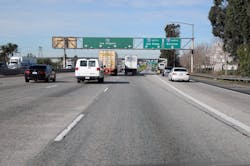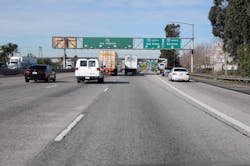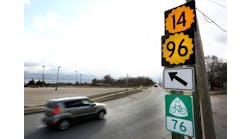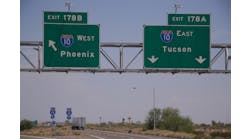By: Tom Tietz and Charles Stuart
In 1947, when Interstate 10 (I-10) was built as a four-lane highway from Ontario to San Bernardino, Calif., it passed through a landscape of ranches, orchards, and open fields fringed with trees. Originally this section of roadway was assigned as U.S. 70-99, and in 1957 it was reassigned to become part of I-10, which stretches from Santa Monica, Calif. to Jacksonville, Fla.
Traces of the historic Rte. 66, or “America’s Main Street,” can still be found running parallel to the I-10 freeway. Today I-10 passes through the familiar urban landscape of homes, business parks and industrial warehouses.
Looking back, it is clear today that California Department of Transportation (Caltrans) highway engineers, working under the provisions of the post-WWII Federal Aid Project, made some outstanding decisions when they designed this concrete pavement back in 1945.
Perhaps the most remarkable feature of this 70-year-old highway is the pavement—an 8-in.-thick section of concrete making up the top layer of the roadway including tie bar reinforcement, an innovative practice at that time.
Much of this original concrete pavement is still in use today and has survived an incredible beating from the unrelenting forces of traffic and time. By today’s Caltrans design standards, to handle the current traffic loads, this pavement should be 50-75% thicker with more reinforcement, dowels and tie bars.
Commenting on the longevity of this section of I-10, Caltrans Director Malcolm Dougherty said, “This is an excellent illustration of the long-lasting benefits of investing in transportation infrastructure, and a strong indication that the work we are doing now to ensure a resilient and sustainable system will serve California’s people and prosperity for generations to come.”
The I-10 corridor now connects Los Angeles, San Bernardino, Palm Springs and the nation, carrying increasing numbers of passenger vehicles, buses and heavy freight trucks. As one of California’s busiest freight freeways, I-10 has stood up well to 24/7 usage with current average daily traffic of 280,000 vehicles, compared to 90,000 vehicles in 1993—an increase of 300% in just over 24 years. Driving along the I-10 freeway today it is hard to imagine how any roadway survives the traffic loads of 100 million vehicles per year with only minor maintenance, but it has endured without significant restoration or upheaval to traffic flow.
Until recently, most concrete pavements were designed for a 20-year life span, and on that basis, the I-10 pavement has lasted about 50 years beyond its design life, an outstanding accomplishment in terms of sustainability, economic benefit and social value.
In 1967, some 20 years after the initial construction, in an effort to reduce congestion and increase mobility, the highway was widened to eight lanes on the section from Vineyard Avenue in Ontario to just east of Valley Boulevard. The new lanes were constructed with concrete pavement on cement treated base. At the same time, the original 1947 concrete pavement was improved using an innovative diamond-grinding process to provide a smoother ride and longer life.
When the first engineers set out to design rigorous specifications for the San Bernardino State Highway (I-10) contract in April of 1945, sustainability was not part of everyday vocabulary. Even so, the highway has proven itself sustainable in every sense. For 70 years it has stood up to the rigors of increasing traffic volume and bigger, heavier truckloads. Indeed, the original engineers and road builders delivered a road that would serve the area for many years without major repairs. Ultimately, the long-lived I-10 freeway has played a beneficial role in establishing California as the world’s eighth largest economy in the United States.
Image: Garret Larson
Maintaining a good surface
Critics accurately assert that our decaying transportation infrastructure is showing serious wear and tear. In addition to the prevalent struggles to find sufficient transportation funding, one of the issues many experts agree upon is that the country’s infrastructure needs upgrading. Poor road conditions contribute to poor livability, impaired mobility and increased costs for motorists. Older highways such as I-10 carry far more truck traffic than their original design lives. In addition, as highway congestion and longer commute times have impacted peoples’ lives, the need to increase capacity becomes imperative.
For those reasons, in about four years the I-10 Corridor Project, under Caltrans’ supervision, will begin construction of two new express lanes in each direction to ease traffic flow between the Los Angeles/San Bernardino County line and Ford Street in Redlands. The new lanes will draw on new technological advances in pavement design and sustainability developed since the original section of I-10 was built.
New pavements will likely include recycled materials; more sustainable, low CO2 cements; optimized concrete mixtures; smoother riding surfaces; innovative paving equipment; and viable options for active transportation.
These advances involving construction productivity include high early strength concrete and pre-cast slabs, which allow repaired roads to open to traffic in as little as four hours. Largely due to this fast-track concrete pavement technology, paving contractors can now rehabilitate highways with minimum traffic interruption. With these improved tools, and as I-10 continues its journey, it will once again prove its worth through many more decades enduring performance and substantiality.
Autonomous and driverless cars or trucks of the future may change the way we drive, but we will still rely on our highways for basic transportation and freight movement. This requires smooth, well-maintained road surfaces for our comfort and safety. Fortunately, I-10 will continue to see heavy-duty trucks move goods and provide services to our interconnected economy well into the future without major rehabilitation.
With I-10, the California economy has benefited from the investment in long-term thinking and far-sighted decisions. The engineering decisions made all those years ago have proven that by using smart pavement designs, quality materials, skilled road-building techniques, and innovative maintenance, our roadways will deliver long-life, with less need for costly maintenance resulting in significant, long-lasting economic value. The I-10 provides today’s engineers and road builders a model for success while also providing a challenge as we look to the future.
How can we ensure the highway pavements built today will exceed expectations and provide tremendous value 70 years later?
About The Author: Tietz is executive director of the California Nevada Cement Association (CNCA). Stuart is executive director of the Southwest Concrete Pavement Association (SWCPA).




